Diabetes Educator Review
VerifiedAdded on 2023/01/06
|12
|3451
|40
AI Summary
This review provides insights into diabetes mellitus, including the causes of hyperglycemia and diabetic ketoacidosis. It also discusses the physiological responses to hypoglycemia and strategies to reduce hypoglycemia events and unawareness in the context of a case study. The review aims to enhance understanding of diabetes management.
Contribute Materials
Your contribution can guide someone’s learning journey. Share your
documents today.
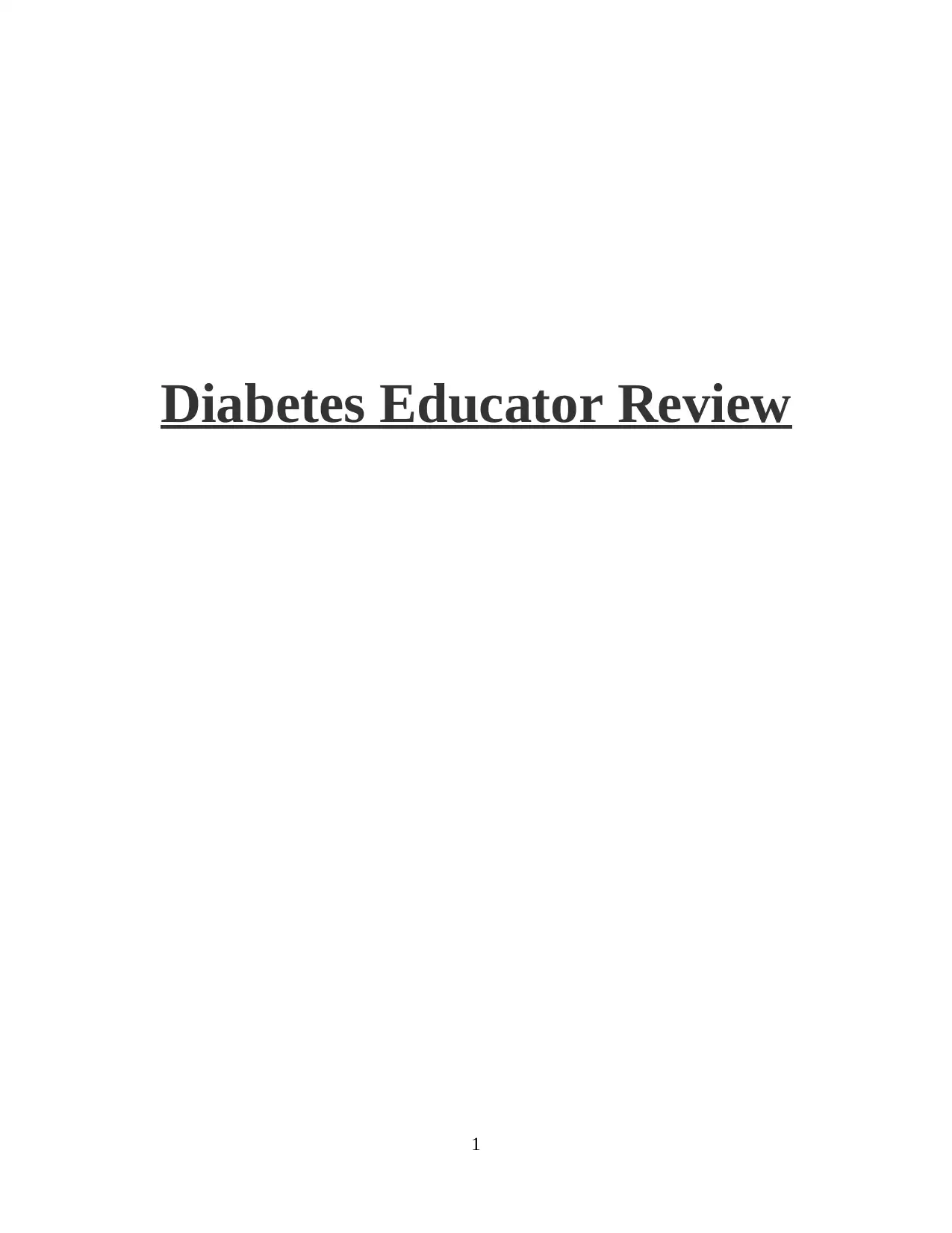
Diabetes Educator Review
1
1
Secure Best Marks with AI Grader
Need help grading? Try our AI Grader for instant feedback on your assignments.

2
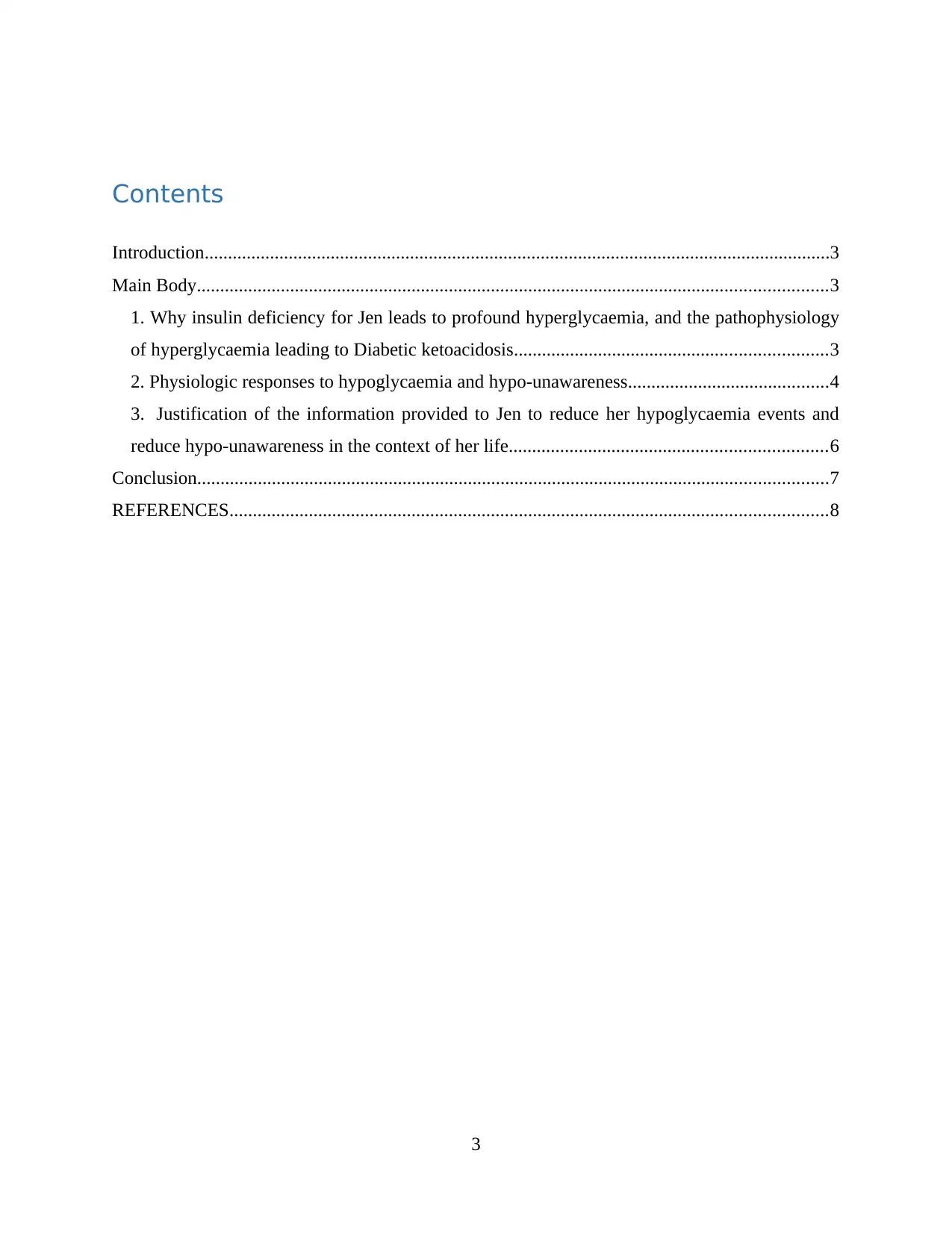
Contents
Introduction......................................................................................................................................3
Main Body.......................................................................................................................................3
1. Why insulin deficiency for Jen leads to profound hyperglycaemia, and the pathophysiology
of hyperglycaemia leading to Diabetic ketoacidosis...................................................................3
2. Physiologic responses to hypoglycaemia and hypo-unawareness...........................................4
3. Justification of the information provided to Jen to reduce her hypoglycaemia events and
reduce hypo-unawareness in the context of her life....................................................................6
Conclusion.......................................................................................................................................7
REFERENCES................................................................................................................................8
3
Introduction......................................................................................................................................3
Main Body.......................................................................................................................................3
1. Why insulin deficiency for Jen leads to profound hyperglycaemia, and the pathophysiology
of hyperglycaemia leading to Diabetic ketoacidosis...................................................................3
2. Physiologic responses to hypoglycaemia and hypo-unawareness...........................................4
3. Justification of the information provided to Jen to reduce her hypoglycaemia events and
reduce hypo-unawareness in the context of her life....................................................................6
Conclusion.......................................................................................................................................7
REFERENCES................................................................................................................................8
3
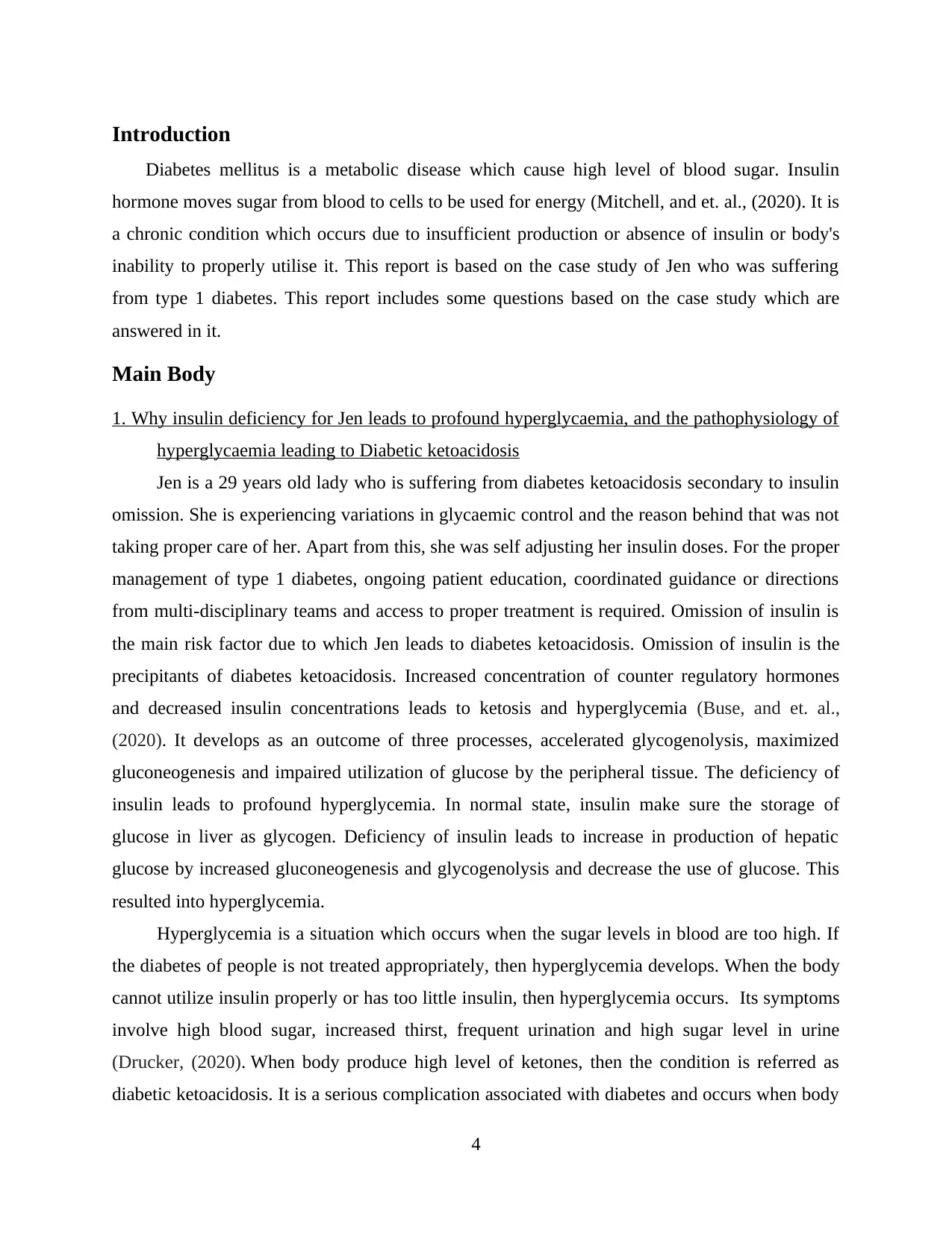
Introduction
Diabetes mellitus is a metabolic disease which cause high level of blood sugar. Insulin
hormone moves sugar from blood to cells to be used for energy (Mitchell, and et. al., (2020). It is
a chronic condition which occurs due to insufficient production or absence of insulin or body's
inability to properly utilise it. This report is based on the case study of Jen who was suffering
from type 1 diabetes. This report includes some questions based on the case study which are
answered in it.
Main Body
1. Why insulin deficiency for Jen leads to profound hyperglycaemia, and the pathophysiology of
hyperglycaemia leading to Diabetic ketoacidosis
Jen is a 29 years old lady who is suffering from diabetes ketoacidosis secondary to insulin
omission. She is experiencing variations in glycaemic control and the reason behind that was not
taking proper care of her. Apart from this, she was self adjusting her insulin doses. For the proper
management of type 1 diabetes, ongoing patient education, coordinated guidance or directions
from multi-disciplinary teams and access to proper treatment is required. Omission of insulin is
the main risk factor due to which Jen leads to diabetes ketoacidosis. Omission of insulin is the
precipitants of diabetes ketoacidosis. Increased concentration of counter regulatory hormones
and decreased insulin concentrations leads to ketosis and hyperglycemia (Buse, and et. al.,
(2020). It develops as an outcome of three processes, accelerated glycogenolysis, maximized
gluconeogenesis and impaired utilization of glucose by the peripheral tissue. The deficiency of
insulin leads to profound hyperglycemia. In normal state, insulin make sure the storage of
glucose in liver as glycogen. Deficiency of insulin leads to increase in production of hepatic
glucose by increased gluconeogenesis and glycogenolysis and decrease the use of glucose. This
resulted into hyperglycemia.
Hyperglycemia is a situation which occurs when the sugar levels in blood are too high. If
the diabetes of people is not treated appropriately, then hyperglycemia develops. When the body
cannot utilize insulin properly or has too little insulin, then hyperglycemia occurs. Its symptoms
involve high blood sugar, increased thirst, frequent urination and high sugar level in urine
(Drucker, (2020). When body produce high level of ketones, then the condition is referred as
diabetic ketoacidosis. It is a serious complication associated with diabetes and occurs when body
4
Diabetes mellitus is a metabolic disease which cause high level of blood sugar. Insulin
hormone moves sugar from blood to cells to be used for energy (Mitchell, and et. al., (2020). It is
a chronic condition which occurs due to insufficient production or absence of insulin or body's
inability to properly utilise it. This report is based on the case study of Jen who was suffering
from type 1 diabetes. This report includes some questions based on the case study which are
answered in it.
Main Body
1. Why insulin deficiency for Jen leads to profound hyperglycaemia, and the pathophysiology of
hyperglycaemia leading to Diabetic ketoacidosis
Jen is a 29 years old lady who is suffering from diabetes ketoacidosis secondary to insulin
omission. She is experiencing variations in glycaemic control and the reason behind that was not
taking proper care of her. Apart from this, she was self adjusting her insulin doses. For the proper
management of type 1 diabetes, ongoing patient education, coordinated guidance or directions
from multi-disciplinary teams and access to proper treatment is required. Omission of insulin is
the main risk factor due to which Jen leads to diabetes ketoacidosis. Omission of insulin is the
precipitants of diabetes ketoacidosis. Increased concentration of counter regulatory hormones
and decreased insulin concentrations leads to ketosis and hyperglycemia (Buse, and et. al.,
(2020). It develops as an outcome of three processes, accelerated glycogenolysis, maximized
gluconeogenesis and impaired utilization of glucose by the peripheral tissue. The deficiency of
insulin leads to profound hyperglycemia. In normal state, insulin make sure the storage of
glucose in liver as glycogen. Deficiency of insulin leads to increase in production of hepatic
glucose by increased gluconeogenesis and glycogenolysis and decrease the use of glucose. This
resulted into hyperglycemia.
Hyperglycemia is a situation which occurs when the sugar levels in blood are too high. If
the diabetes of people is not treated appropriately, then hyperglycemia develops. When the body
cannot utilize insulin properly or has too little insulin, then hyperglycemia occurs. Its symptoms
involve high blood sugar, increased thirst, frequent urination and high sugar level in urine
(Drucker, (2020). When body produce high level of ketones, then the condition is referred as
diabetic ketoacidosis. It is a serious complication associated with diabetes and occurs when body
4
Secure Best Marks with AI Grader
Need help grading? Try our AI Grader for instant feedback on your assignments.

cannot produce required insulin. The disease is usually triggered through illness and issue with
insulin therapy. The other possible triggers include heart attack, alcohol or drug abuse, emotional
and physical trauma inserting medications like diuretics and corticosteroids. In case of Jen, her
level of Ketones in body is high, i.e., 6 due to which she faces may face the issue of Diabetes
Ketoacidosis.
Pathophysiology of hyperglycemia leading to diabetes ketoacidosis:
Hyperglycemia is the outcome of immunologic, environmental and genetic factors which
leads to destruction of beta cells in pancreas and insulin deficiency. Increased insulin counter
regulatory hormones like growth hormone, glucagon, catecholamines and cortisol, peripheral
insulin resistance and insulin deficiency lead to dehydration, electrolyte imbalance,
hyperglycemia and ketosis which underline pathophysiology of diabetes ketoacidosis (Flatt, and
et. al., (2020). Hyperglycemia of diabetes ketoacidosis evolves by accelerated glycogenolysis,
gluconeogenesis and decreased utilization of glucose - all because of deficiency of absolute
insulin. Of note, the patient with diabetes who develop diabetes ketoacidosis when treated with
SGLT-2 inhibitors can exist without hyperglycemia, that is, with euglycemic diabetes
ketoacidosis. Because of decreased lipogenesis and maximize lipolysis, abundant free fatty acids
are transform to ketone bodies including acetone, acetoacetate and beta hydroxy butyrate.
The hyperglycemia induced osmotic diuresis when not accompanied through adequate
intake of oral fluid, leads to dehydration, electrolyte loss, hyperosmolarity as well as subsequent
decline in glomerular filtration (PATHOPHYSIOLOGY OF HYPERGLYCEMIA, 2018). The
glycosuria diminishes with decrease in renal function and hyperosmolarity / hyperglycemia
worsens. With hyperosmolarity as well as impaired insulin action, the use of potassium through
skeletal muscle is diminished which leads to intracellular potassium depletion. Apart from this,
potassium is also lost through osmotic diuresis which cause profound deficiency of total body
potassium. Thus, the patient with diabetes ketoacidosis can present with wide range of
concentrations of serum potassium. Nevertheless, normal level of plasma potassium
concentration may depict that potassium is a store in the body of patient are diminished severely
and the correction of hyperglycemia and institution of insulin therapy leads to future
hypokalemia (Fanelli, and et. al., (2020).
2. Physiologic responses to hypoglycaemia and hypo-unawareness
Physiological responses to hypoglycemia:
5
insulin therapy. The other possible triggers include heart attack, alcohol or drug abuse, emotional
and physical trauma inserting medications like diuretics and corticosteroids. In case of Jen, her
level of Ketones in body is high, i.e., 6 due to which she faces may face the issue of Diabetes
Ketoacidosis.
Pathophysiology of hyperglycemia leading to diabetes ketoacidosis:
Hyperglycemia is the outcome of immunologic, environmental and genetic factors which
leads to destruction of beta cells in pancreas and insulin deficiency. Increased insulin counter
regulatory hormones like growth hormone, glucagon, catecholamines and cortisol, peripheral
insulin resistance and insulin deficiency lead to dehydration, electrolyte imbalance,
hyperglycemia and ketosis which underline pathophysiology of diabetes ketoacidosis (Flatt, and
et. al., (2020). Hyperglycemia of diabetes ketoacidosis evolves by accelerated glycogenolysis,
gluconeogenesis and decreased utilization of glucose - all because of deficiency of absolute
insulin. Of note, the patient with diabetes who develop diabetes ketoacidosis when treated with
SGLT-2 inhibitors can exist without hyperglycemia, that is, with euglycemic diabetes
ketoacidosis. Because of decreased lipogenesis and maximize lipolysis, abundant free fatty acids
are transform to ketone bodies including acetone, acetoacetate and beta hydroxy butyrate.
The hyperglycemia induced osmotic diuresis when not accompanied through adequate
intake of oral fluid, leads to dehydration, electrolyte loss, hyperosmolarity as well as subsequent
decline in glomerular filtration (PATHOPHYSIOLOGY OF HYPERGLYCEMIA, 2018). The
glycosuria diminishes with decrease in renal function and hyperosmolarity / hyperglycemia
worsens. With hyperosmolarity as well as impaired insulin action, the use of potassium through
skeletal muscle is diminished which leads to intracellular potassium depletion. Apart from this,
potassium is also lost through osmotic diuresis which cause profound deficiency of total body
potassium. Thus, the patient with diabetes ketoacidosis can present with wide range of
concentrations of serum potassium. Nevertheless, normal level of plasma potassium
concentration may depict that potassium is a store in the body of patient are diminished severely
and the correction of hyperglycemia and institution of insulin therapy leads to future
hypokalemia (Fanelli, and et. al., (2020).
2. Physiologic responses to hypoglycaemia and hypo-unawareness
Physiological responses to hypoglycemia:
5

With the intact of counter regulatory components, a drop in plasma glucose outcomes in
main physiological defenses against declining concentrations of plasma glucose: rise in
pancreatic Alpha cell glucagon secretion, decline in pancreatic beta cell insulin secretion and rise
in secretion of adrenomedullary epinephrine. It also outcomes in hypoglycemic symptoms
perception which are highly sympathetic neutral as well as that prompt ingestion of carbohydrate
(PHYSIOLOGICAL RESPONSES TO HYPOGLYCEMIA, 2011).
Glucagon and insulin: the initial response to declining levels of glucose is decreased
secretion of insulin. As plasma glucose falls continuously, glucagon is released by incompletely
understood mechanism. Similar to beta cells, Alpha cells express KATP channels and
glucokinase so low glucose concentrations can sense directly.
Sympathoadrenal response: normally, 3.6 - 3.9 mmol/L of plasma glucose level
increases catecholamine mediated as well as acetylcholine mediated neurotransmission in
peripheral autonomic nervous system and central nervous system. The level of glucose at which
catecholamine responses activation occur in child has been depicted to be high in comparison to
adult and differs with glycemic control level (Pratley, and et. al., (2020). The sympathoadrenal
response involves adrenal medulla activation to secrete norepinephrine and epinephrine along
with activation of sympathetic nervous system in order to release acetylcholine and
norepinephrine. Gluconeogenic precursors co-infusion with epinephrine and glucagon further
augmented this rise in production of hepatic glucose through maximizing gluconeogenesis after
60 minutes’ issues that gluconeogenic precursors peripheral production is limiting element in
hepatic gluconeogenesis induced through epinephrine and glucagon.
Cortisol and growth hormone: contrasting to rapid effects of epinephrine and glucagon
on regulation of glucose, the effect of cortisol and growth hormone at the time of hypoglycemia
are delayed. In selective replacement through pancreatic adrenocortical pituitary clamp along
with subcutaneous insulin infusion and pharmacologically induced suppression of glucose
counter regulatory hormones in people, lack of cortisol increase outcomes in low rate of
production of glucose and increased rate of use of glucose after 6 hours when growth hormone,
insulin and glucagon were infused in order to maintain similar plasma concentrations (Fabris,
and et. al., (2020).
Physiological responses to hypoglycemia unawareness:
6
main physiological defenses against declining concentrations of plasma glucose: rise in
pancreatic Alpha cell glucagon secretion, decline in pancreatic beta cell insulin secretion and rise
in secretion of adrenomedullary epinephrine. It also outcomes in hypoglycemic symptoms
perception which are highly sympathetic neutral as well as that prompt ingestion of carbohydrate
(PHYSIOLOGICAL RESPONSES TO HYPOGLYCEMIA, 2011).
Glucagon and insulin: the initial response to declining levels of glucose is decreased
secretion of insulin. As plasma glucose falls continuously, glucagon is released by incompletely
understood mechanism. Similar to beta cells, Alpha cells express KATP channels and
glucokinase so low glucose concentrations can sense directly.
Sympathoadrenal response: normally, 3.6 - 3.9 mmol/L of plasma glucose level
increases catecholamine mediated as well as acetylcholine mediated neurotransmission in
peripheral autonomic nervous system and central nervous system. The level of glucose at which
catecholamine responses activation occur in child has been depicted to be high in comparison to
adult and differs with glycemic control level (Pratley, and et. al., (2020). The sympathoadrenal
response involves adrenal medulla activation to secrete norepinephrine and epinephrine along
with activation of sympathetic nervous system in order to release acetylcholine and
norepinephrine. Gluconeogenic precursors co-infusion with epinephrine and glucagon further
augmented this rise in production of hepatic glucose through maximizing gluconeogenesis after
60 minutes’ issues that gluconeogenic precursors peripheral production is limiting element in
hepatic gluconeogenesis induced through epinephrine and glucagon.
Cortisol and growth hormone: contrasting to rapid effects of epinephrine and glucagon
on regulation of glucose, the effect of cortisol and growth hormone at the time of hypoglycemia
are delayed. In selective replacement through pancreatic adrenocortical pituitary clamp along
with subcutaneous insulin infusion and pharmacologically induced suppression of glucose
counter regulatory hormones in people, lack of cortisol increase outcomes in low rate of
production of glucose and increased rate of use of glucose after 6 hours when growth hormone,
insulin and glucagon were infused in order to maintain similar plasma concentrations (Fabris,
and et. al., (2020).
Physiological responses to hypoglycemia unawareness:
6

Hypoglycemia unawareness is referred as the beginning of neuroglycopenia previous the
autonomic warning symptoms appearance. In patients with diabetes mellitus like Jen, recurrent
hypoglycemia has been depicted to decline the level of glucose that precipitates counter
regulatory response required to restore euglycemia at the time of subsequent hypoglycemia
episode. The key risk factors for hypoglycemia unawareness development includes duration of
disease as well as enhanced metabolic control (Lacy, and et. al., (2020). Hypoglycemia
unawareness severity is related to longer duration of diabetes and history of frequent lower level
of glycemic. Whereas, but blood glucose decreasing rate and aging, which declines from near
level of blood glucose are risk of severe hypoglycemia unawareness. Aberrant glucose counter
regulation hypoglycemia unawareness are the elements of hypoglycemia related autonomic
failure in the patients of diabetes. It is often caused due to recurrent or recent iatrogenic
hypoglycemia, as well as in death hypoglycemia related autonomic failure is maintained through
recurrent hypoglycemia. Patients with type 1 diabetes have been constrained through adverse
impacts of insulin induced hypoglycemia (Chow, & Seaquist, (2020). Hypoglycemia
unawareness is related to diminished response of brain to mild hypoglycemia. In addition to this,
the pattern of brain responses loss appears to include fronto-parietal and cortico-striatal neuro
circuits which play a significant role in regulating goal-directed behavior and motivation and
attention, thus are possibly to have implications for understanding the reason people with
hypoglycemia unawareness are failed to appropriately respond to falling levels of blood glucose.
3. Justification of the information provided to Jen to reduce her hypoglycaemia events and
reduce hypo-unawareness in the context of her life
The hypoglycemia unawareness happens when someone does not perceive or experience
hypoglycemia symptoms which typically happen when the level of blood sugar declines below
54 mg/dl. It has been depicted by the study that people with hypoglycemia unawareness are at
high risk of experience severe hypoglycemia as they are less possibly to identify early alert signs
like hunger, sweating or shakiness. Another symptoms involves neuroglycopenic symptoms that
outcomes from impaired function of brain because of low level of blood sugar and non-specific
symptoms. Some of the factors which are associated with hypoglycemic unawareness includes
exercise as the possibility of hypoglycemia is maximized after and during the exercise. While
exercising, the tissues of body are more sensitive to insulin (Kwan, and et. al., (2020). Another
factor is going low while sleeping as many individuals develop hypoglycemia when they are
7
autonomic warning symptoms appearance. In patients with diabetes mellitus like Jen, recurrent
hypoglycemia has been depicted to decline the level of glucose that precipitates counter
regulatory response required to restore euglycemia at the time of subsequent hypoglycemia
episode. The key risk factors for hypoglycemia unawareness development includes duration of
disease as well as enhanced metabolic control (Lacy, and et. al., (2020). Hypoglycemia
unawareness severity is related to longer duration of diabetes and history of frequent lower level
of glycemic. Whereas, but blood glucose decreasing rate and aging, which declines from near
level of blood glucose are risk of severe hypoglycemia unawareness. Aberrant glucose counter
regulation hypoglycemia unawareness are the elements of hypoglycemia related autonomic
failure in the patients of diabetes. It is often caused due to recurrent or recent iatrogenic
hypoglycemia, as well as in death hypoglycemia related autonomic failure is maintained through
recurrent hypoglycemia. Patients with type 1 diabetes have been constrained through adverse
impacts of insulin induced hypoglycemia (Chow, & Seaquist, (2020). Hypoglycemia
unawareness is related to diminished response of brain to mild hypoglycemia. In addition to this,
the pattern of brain responses loss appears to include fronto-parietal and cortico-striatal neuro
circuits which play a significant role in regulating goal-directed behavior and motivation and
attention, thus are possibly to have implications for understanding the reason people with
hypoglycemia unawareness are failed to appropriately respond to falling levels of blood glucose.
3. Justification of the information provided to Jen to reduce her hypoglycaemia events and
reduce hypo-unawareness in the context of her life
The hypoglycemia unawareness happens when someone does not perceive or experience
hypoglycemia symptoms which typically happen when the level of blood sugar declines below
54 mg/dl. It has been depicted by the study that people with hypoglycemia unawareness are at
high risk of experience severe hypoglycemia as they are less possibly to identify early alert signs
like hunger, sweating or shakiness. Another symptoms involves neuroglycopenic symptoms that
outcomes from impaired function of brain because of low level of blood sugar and non-specific
symptoms. Some of the factors which are associated with hypoglycemic unawareness includes
exercise as the possibility of hypoglycemia is maximized after and during the exercise. While
exercising, the tissues of body are more sensitive to insulin (Kwan, and et. al., (2020). Another
factor is going low while sleeping as many individuals develop hypoglycemia when they are
7
Paraphrase This Document
Need a fresh take? Get an instant paraphrase of this document with our AI Paraphraser
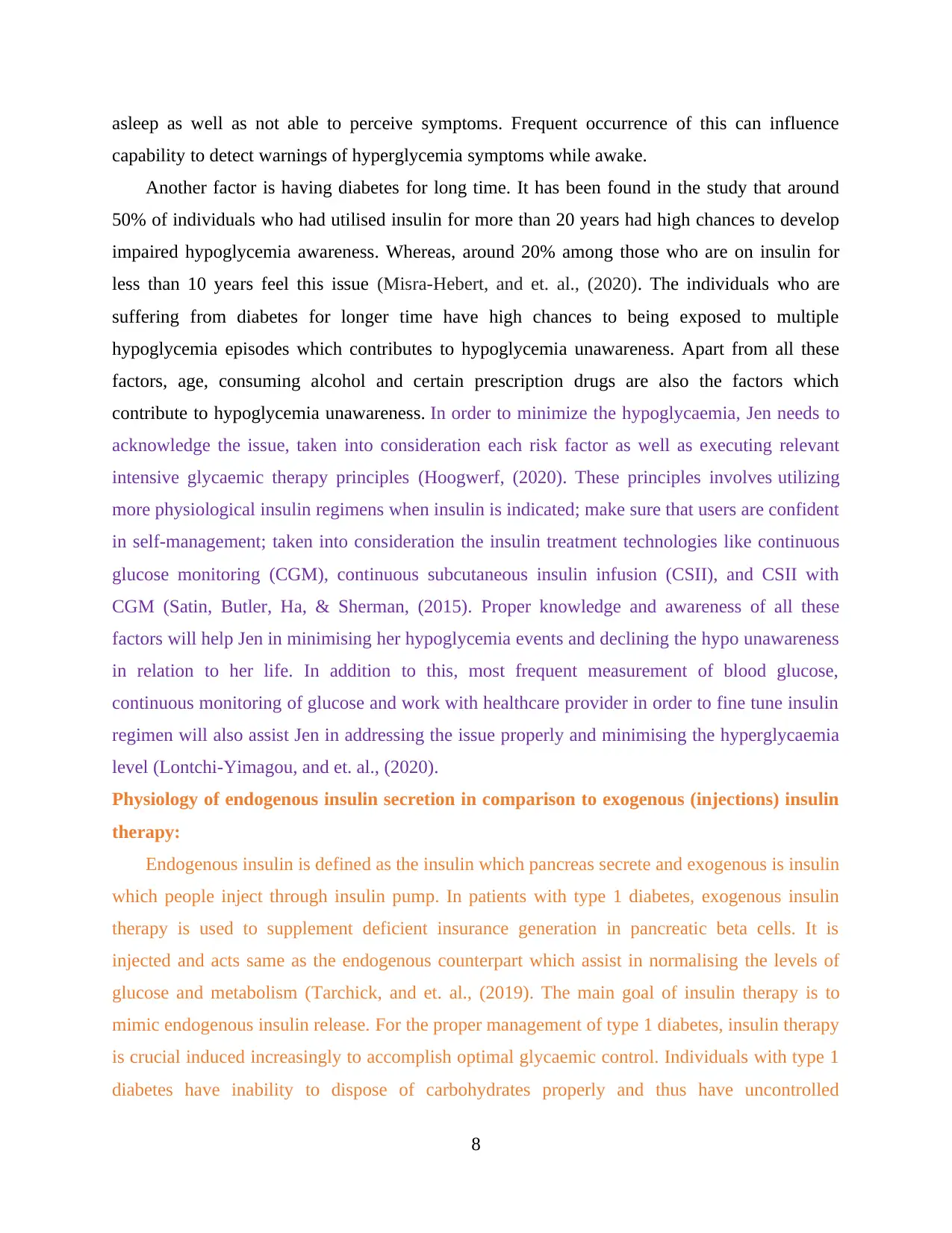
asleep as well as not able to perceive symptoms. Frequent occurrence of this can influence
capability to detect warnings of hyperglycemia symptoms while awake.
Another factor is having diabetes for long time. It has been found in the study that around
50% of individuals who had utilised insulin for more than 20 years had high chances to develop
impaired hypoglycemia awareness. Whereas, around 20% among those who are on insulin for
less than 10 years feel this issue (Misra-Hebert, and et. al., (2020). The individuals who are
suffering from diabetes for longer time have high chances to being exposed to multiple
hypoglycemia episodes which contributes to hypoglycemia unawareness. Apart from all these
factors, age, consuming alcohol and certain prescription drugs are also the factors which
contribute to hypoglycemia unawareness. In order to minimize the hypoglycaemia, Jen needs to
acknowledge the issue, taken into consideration each risk factor as well as executing relevant
intensive glycaemic therapy principles (Hoogwerf, (2020). These principles involves utilizing
more physiological insulin regimens when insulin is indicated; make sure that users are confident
in self-management; taken into consideration the insulin treatment technologies like continuous
glucose monitoring (CGM), continuous subcutaneous insulin infusion (CSII), and CSII with
CGM (Satin, Butler, Ha, & Sherman, (2015). Proper knowledge and awareness of all these
factors will help Jen in minimising her hypoglycemia events and declining the hypo unawareness
in relation to her life. In addition to this, most frequent measurement of blood glucose,
continuous monitoring of glucose and work with healthcare provider in order to fine tune insulin
regimen will also assist Jen in addressing the issue properly and minimising the hyperglycaemia
level (Lontchi-Yimagou, and et. al., (2020).
Physiology of endogenous insulin secretion in comparison to exogenous (injections) insulin
therapy:
Endogenous insulin is defined as the insulin which pancreas secrete and exogenous is insulin
which people inject through insulin pump. In patients with type 1 diabetes, exogenous insulin
therapy is used to supplement deficient insurance generation in pancreatic beta cells. It is
injected and acts same as the endogenous counterpart which assist in normalising the levels of
glucose and metabolism (Tarchick, and et. al., (2019). The main goal of insulin therapy is to
mimic endogenous insulin release. For the proper management of type 1 diabetes, insulin therapy
is crucial induced increasingly to accomplish optimal glycaemic control. Individuals with type 1
diabetes have inability to dispose of carbohydrates properly and thus have uncontrolled
8
capability to detect warnings of hyperglycemia symptoms while awake.
Another factor is having diabetes for long time. It has been found in the study that around
50% of individuals who had utilised insulin for more than 20 years had high chances to develop
impaired hypoglycemia awareness. Whereas, around 20% among those who are on insulin for
less than 10 years feel this issue (Misra-Hebert, and et. al., (2020). The individuals who are
suffering from diabetes for longer time have high chances to being exposed to multiple
hypoglycemia episodes which contributes to hypoglycemia unawareness. Apart from all these
factors, age, consuming alcohol and certain prescription drugs are also the factors which
contribute to hypoglycemia unawareness. In order to minimize the hypoglycaemia, Jen needs to
acknowledge the issue, taken into consideration each risk factor as well as executing relevant
intensive glycaemic therapy principles (Hoogwerf, (2020). These principles involves utilizing
more physiological insulin regimens when insulin is indicated; make sure that users are confident
in self-management; taken into consideration the insulin treatment technologies like continuous
glucose monitoring (CGM), continuous subcutaneous insulin infusion (CSII), and CSII with
CGM (Satin, Butler, Ha, & Sherman, (2015). Proper knowledge and awareness of all these
factors will help Jen in minimising her hypoglycemia events and declining the hypo unawareness
in relation to her life. In addition to this, most frequent measurement of blood glucose,
continuous monitoring of glucose and work with healthcare provider in order to fine tune insulin
regimen will also assist Jen in addressing the issue properly and minimising the hyperglycaemia
level (Lontchi-Yimagou, and et. al., (2020).
Physiology of endogenous insulin secretion in comparison to exogenous (injections) insulin
therapy:
Endogenous insulin is defined as the insulin which pancreas secrete and exogenous is insulin
which people inject through insulin pump. In patients with type 1 diabetes, exogenous insulin
therapy is used to supplement deficient insurance generation in pancreatic beta cells. It is
injected and acts same as the endogenous counterpart which assist in normalising the levels of
glucose and metabolism (Tarchick, and et. al., (2019). The main goal of insulin therapy is to
mimic endogenous insulin release. For the proper management of type 1 diabetes, insulin therapy
is crucial induced increasingly to accomplish optimal glycaemic control. Individuals with type 1
diabetes have inability to dispose of carbohydrates properly and thus have uncontrolled
8

fluctuations in the glucose in blood. Severe but reversible impairment causes by hyper glycaemia
in impairment of beta cells as well as promote the complications of diabetes. Significantly, there
are two ways or methods to dampen harmful extrusions of glucose: i) moderate glucose intake or
ii) and enhance disposal of glucose either through independently or insulin system
(EXOGENOUS AND ENDOGENOUS INSULIN IN TYPE 1 DIABETES, 2018). When insulin
is administered through slow intravenous infusion in a way which reduce or prevent
hypoglycaemia as well as its counter regulatory response, a decrease in hepatic glucose output
ensured. On the other side, insulin is given through rapid intravenous injection, the output of
hepatic glucose either increased or remain unchanged.
The basal bolus insulin therapy includes taking a form of insulin which is long acting in
order to keep the level of blood glucose stable by fasting period as well as separate injections of
short acting insulin in order to prevent increase in level of blood glucose resulting from meals.
The main role of basal insulin is to keep the level of blood glucose consistent during fasting
period. It is required to keep the level of blood glucose under control and enable cells to get a
glucose for energy (Satin, Butler, Ha, & Sherman, (2015). In a person with type 1 diabetes like
Jen, it allows her to self-adjust her insulin doses which means that she have the flexibility over
the amount of carbohydrate she can take in different meals. Type 1 diabetic patient take rapid
acting insulin and long acting insulin.
The continuous subcutaneous insulin infusion includes wearing insulin pump that gives a
steady insulin steam into body. It allows a patient to take instantaneous action to assist decrease
on increased levels of blood glucose (Insulin Pump Therapy, 2019). As Jen was suffering from
type 1 diabetes, she can take insulin pump therapy as an intervention to manage her level of
blood glucose effectively. It helps her in having better control over diabetes and provide her with
the ability to increase or decrease the level of blood glucose on demand. For instance: if Jen has
complete knowledge of continuous subcutaneous insulin infusion, then while participated in
marathon, she may select to suspend insulin delivery for preventing hypoglycaemia from
occurring. Alterations to delivery of insulin will require to be supported through sound
understanding of insulin requirement of body for distinct activities and frequent testing of blood
glucose (Szypowska and et. al., (2016).
9
in impairment of beta cells as well as promote the complications of diabetes. Significantly, there
are two ways or methods to dampen harmful extrusions of glucose: i) moderate glucose intake or
ii) and enhance disposal of glucose either through independently or insulin system
(EXOGENOUS AND ENDOGENOUS INSULIN IN TYPE 1 DIABETES, 2018). When insulin
is administered through slow intravenous infusion in a way which reduce or prevent
hypoglycaemia as well as its counter regulatory response, a decrease in hepatic glucose output
ensured. On the other side, insulin is given through rapid intravenous injection, the output of
hepatic glucose either increased or remain unchanged.
The basal bolus insulin therapy includes taking a form of insulin which is long acting in
order to keep the level of blood glucose stable by fasting period as well as separate injections of
short acting insulin in order to prevent increase in level of blood glucose resulting from meals.
The main role of basal insulin is to keep the level of blood glucose consistent during fasting
period. It is required to keep the level of blood glucose under control and enable cells to get a
glucose for energy (Satin, Butler, Ha, & Sherman, (2015). In a person with type 1 diabetes like
Jen, it allows her to self-adjust her insulin doses which means that she have the flexibility over
the amount of carbohydrate she can take in different meals. Type 1 diabetic patient take rapid
acting insulin and long acting insulin.
The continuous subcutaneous insulin infusion includes wearing insulin pump that gives a
steady insulin steam into body. It allows a patient to take instantaneous action to assist decrease
on increased levels of blood glucose (Insulin Pump Therapy, 2019). As Jen was suffering from
type 1 diabetes, she can take insulin pump therapy as an intervention to manage her level of
blood glucose effectively. It helps her in having better control over diabetes and provide her with
the ability to increase or decrease the level of blood glucose on demand. For instance: if Jen has
complete knowledge of continuous subcutaneous insulin infusion, then while participated in
marathon, she may select to suspend insulin delivery for preventing hypoglycaemia from
occurring. Alterations to delivery of insulin will require to be supported through sound
understanding of insulin requirement of body for distinct activities and frequent testing of blood
glucose (Szypowska and et. al., (2016).
9
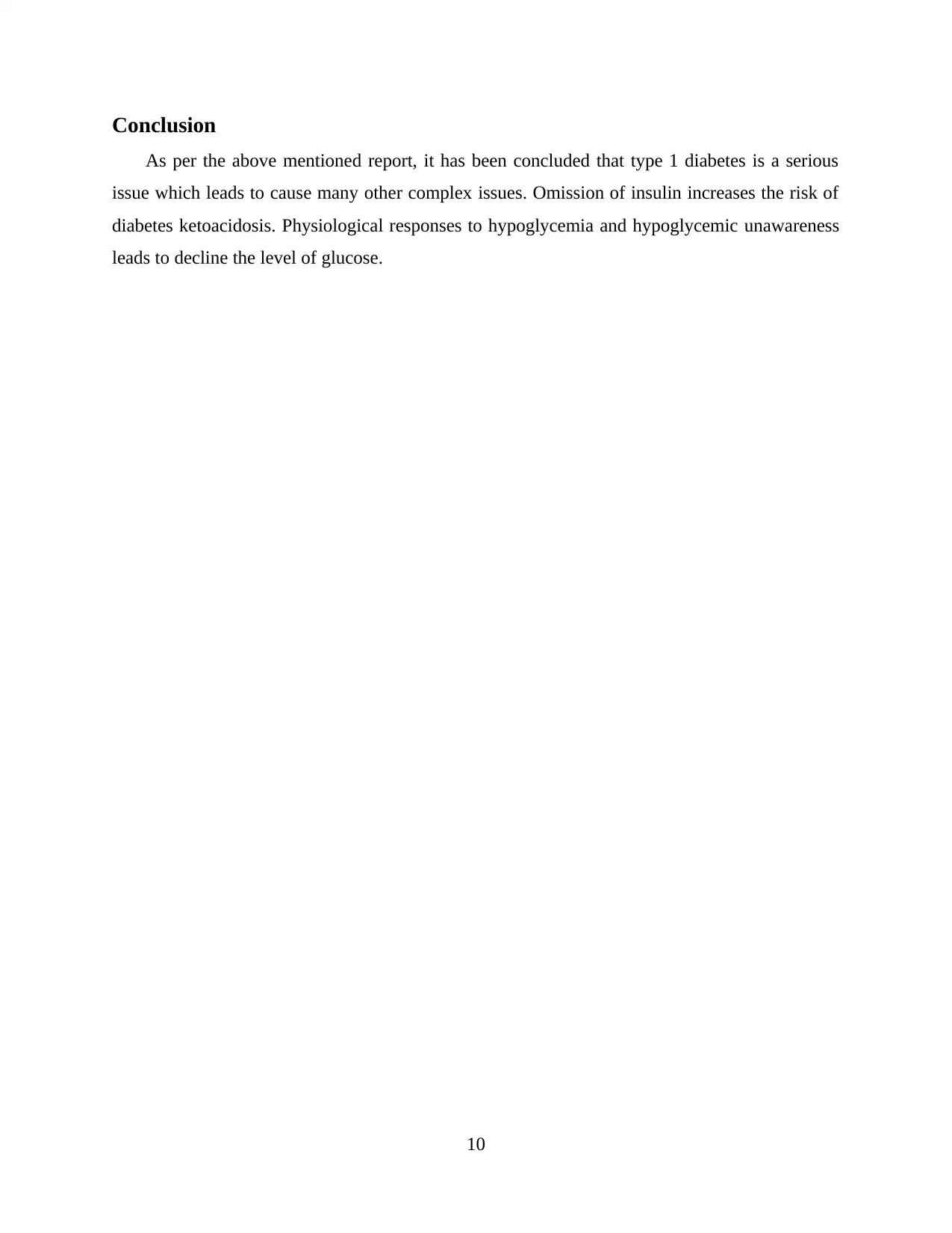
Conclusion
As per the above mentioned report, it has been concluded that type 1 diabetes is a serious
issue which leads to cause many other complex issues. Omission of insulin increases the risk of
diabetes ketoacidosis. Physiological responses to hypoglycemia and hypoglycemic unawareness
leads to decline the level of glucose.
10
As per the above mentioned report, it has been concluded that type 1 diabetes is a serious
issue which leads to cause many other complex issues. Omission of insulin increases the risk of
diabetes ketoacidosis. Physiological responses to hypoglycemia and hypoglycemic unawareness
leads to decline the level of glucose.
10
Secure Best Marks with AI Grader
Need help grading? Try our AI Grader for instant feedback on your assignments.

REFERENCES
Books and Journals
Buse, J. B., and et. al., (2020). 2019 update to: management of hyperglycemia in type 2 diabetes,
2018. A consensus report by the American Diabetes Association (ADA) and the
European Association for the Study of Diabetes (EASD). Diabetes Care, 43(2), 487-493.
Drucker, D. J. (2020). Coronavirus infections and type 2 diabetes—shared pathways with
therapeutic implications. Endocrine reviews, 41(3), bnaa011.
Flatt, A. J., and et. al., (2020). Predictors of recurrent severe hypoglycemia in adults with type 1
diabetes and impaired awareness of hypoglycemia during the HypoCOMPaSS
study. Diabetes care, 43(1), 44-52.
Fanelli, C. G., and et. al., (2020). Hypoglycemia. Diabetes Complications, Comorbidities and
Related Disorders, 615-652.
Pratley, R. E., and et. al., (2020). Effect of continuous glucose monitoring on hypoglycemia in
older adults with type 1 diabetes: a randomized clinical trial. Jama, 323(23), 2397-2406.
Fabris, C., and et. al., (2020). The Use of a Smart Bolus Calculator Informed by Real-time
Insulin Sensitivity Assessments Reduces Postprandial Hypoglycemia Following an
Aerobic Exercise Session in Individuals With Type 1 Diabetes. Diabetes Care, 43(4),
799-805.
Lacy, M. E., and et. al., (2020). Severe Hypoglycemia and Cognitive Function in Older Adults
With Type 1 Diabetes: The Study of Longevity in Diabetes (SOLID). Diabetes
Care, 43(3), 541-548.
Chow, L., & Seaquist, E. R. (2020). How Significant Is Severe Hypoglycemia in Older Adults
With Diabetes?. Diabetes care, 43(3), 512-514.
Kwan, T. N., and et. al., (2020). Relative hypoglycemia in diabetic patients with critical
illness. Critical Care Medicine, 48(3), e233-e240.
Misra-Hebert, A. D., and et. al., (2020). Risk prediction for severe hypoglycemia in a type 2
diabetes population with previous non-severe hypoglycemia. Journal of Diabetes and its
Complications, 34(1), 107490.
Hoogwerf, B. J. (2020). Hypoglycemia in Older Patients. Clinics in Geriatric Medicine, 36(3),
395-406.
Lontchi-Yimagou, E., and et. al., (2020). Plasma Epinephrine Contributes to the Development of
Experimental Hypoglycemia-Associated Autonomic Failure. The Journal of Clinical
Endocrinology & Metabolism, 105(11), dgaa539.
Mitchell, S. L., and et. al., (2020). Pharmacogenetics of hypoglycemia associated with
sulfonylurea therapy in usual clinical care. The Pharmacogenomics Journal, 1-9.
Szypowska, A. and et. al., (2016). Insulin pump therapy in children with type 1 diabetes:
analysis of data from the SWEET registry. Pediatric diabetes, 17, 38-45.
Tarchick, M. J., and et. al., (2019). Endogenous insulin signaling in the RPE contributes to the
maintenance of rod photoreceptor function in diabetes. Experimental eye research, 180,
63-74.
Satin, L. S., Butler, P. C., Ha, J., & Sherman, A. S. (2015). Pulsatile insulin secretion, impaired
glucose tolerance and type 2 diabetes. Molecular aspects of medicine, 42, 61-77.
Online
11
Books and Journals
Buse, J. B., and et. al., (2020). 2019 update to: management of hyperglycemia in type 2 diabetes,
2018. A consensus report by the American Diabetes Association (ADA) and the
European Association for the Study of Diabetes (EASD). Diabetes Care, 43(2), 487-493.
Drucker, D. J. (2020). Coronavirus infections and type 2 diabetes—shared pathways with
therapeutic implications. Endocrine reviews, 41(3), bnaa011.
Flatt, A. J., and et. al., (2020). Predictors of recurrent severe hypoglycemia in adults with type 1
diabetes and impaired awareness of hypoglycemia during the HypoCOMPaSS
study. Diabetes care, 43(1), 44-52.
Fanelli, C. G., and et. al., (2020). Hypoglycemia. Diabetes Complications, Comorbidities and
Related Disorders, 615-652.
Pratley, R. E., and et. al., (2020). Effect of continuous glucose monitoring on hypoglycemia in
older adults with type 1 diabetes: a randomized clinical trial. Jama, 323(23), 2397-2406.
Fabris, C., and et. al., (2020). The Use of a Smart Bolus Calculator Informed by Real-time
Insulin Sensitivity Assessments Reduces Postprandial Hypoglycemia Following an
Aerobic Exercise Session in Individuals With Type 1 Diabetes. Diabetes Care, 43(4),
799-805.
Lacy, M. E., and et. al., (2020). Severe Hypoglycemia and Cognitive Function in Older Adults
With Type 1 Diabetes: The Study of Longevity in Diabetes (SOLID). Diabetes
Care, 43(3), 541-548.
Chow, L., & Seaquist, E. R. (2020). How Significant Is Severe Hypoglycemia in Older Adults
With Diabetes?. Diabetes care, 43(3), 512-514.
Kwan, T. N., and et. al., (2020). Relative hypoglycemia in diabetic patients with critical
illness. Critical Care Medicine, 48(3), e233-e240.
Misra-Hebert, A. D., and et. al., (2020). Risk prediction for severe hypoglycemia in a type 2
diabetes population with previous non-severe hypoglycemia. Journal of Diabetes and its
Complications, 34(1), 107490.
Hoogwerf, B. J. (2020). Hypoglycemia in Older Patients. Clinics in Geriatric Medicine, 36(3),
395-406.
Lontchi-Yimagou, E., and et. al., (2020). Plasma Epinephrine Contributes to the Development of
Experimental Hypoglycemia-Associated Autonomic Failure. The Journal of Clinical
Endocrinology & Metabolism, 105(11), dgaa539.
Mitchell, S. L., and et. al., (2020). Pharmacogenetics of hypoglycemia associated with
sulfonylurea therapy in usual clinical care. The Pharmacogenomics Journal, 1-9.
Szypowska, A. and et. al., (2016). Insulin pump therapy in children with type 1 diabetes:
analysis of data from the SWEET registry. Pediatric diabetes, 17, 38-45.
Tarchick, M. J., and et. al., (2019). Endogenous insulin signaling in the RPE contributes to the
maintenance of rod photoreceptor function in diabetes. Experimental eye research, 180,
63-74.
Satin, L. S., Butler, P. C., Ha, J., & Sherman, A. S. (2015). Pulsatile insulin secretion, impaired
glucose tolerance and type 2 diabetes. Molecular aspects of medicine, 42, 61-77.
Online
11
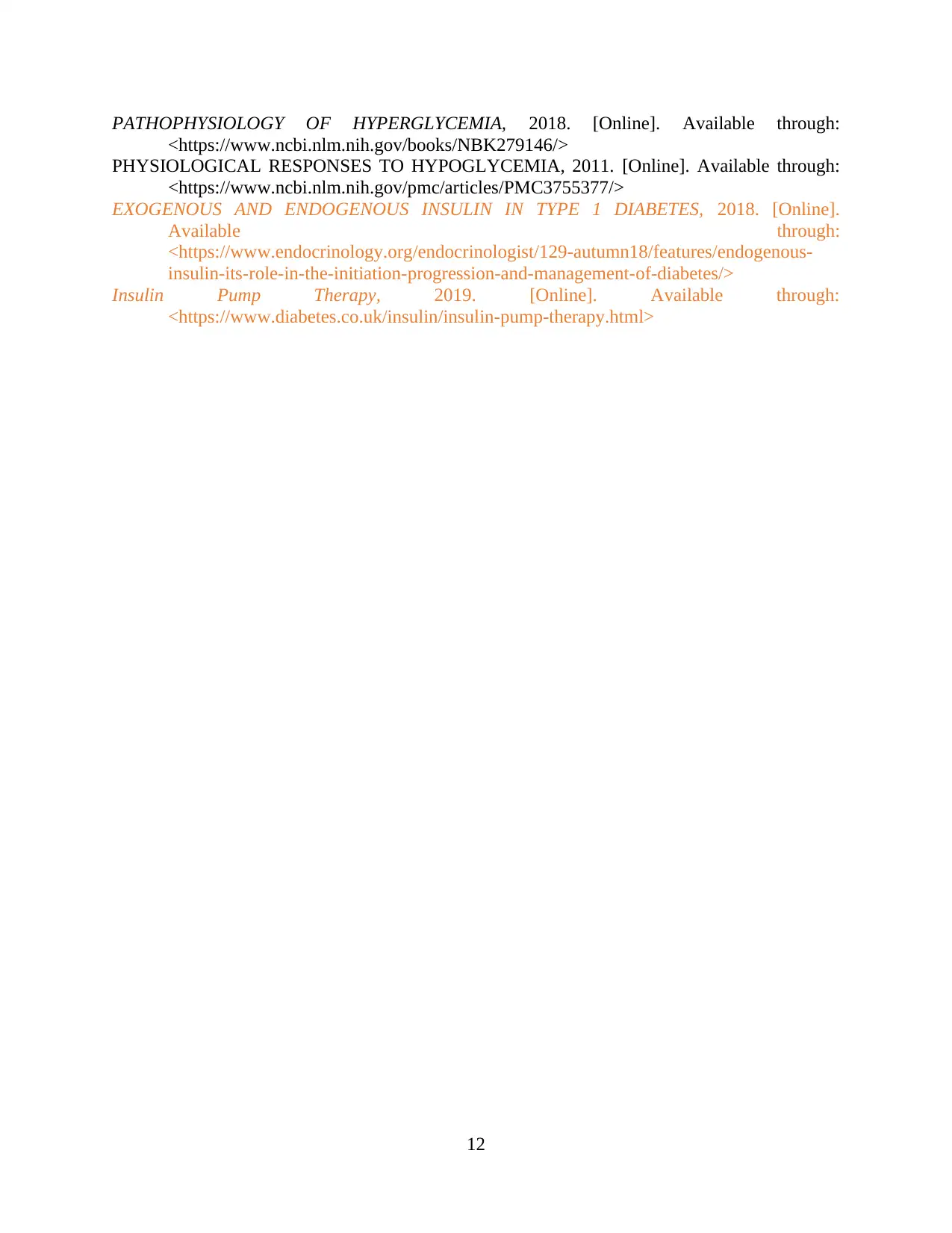
PATHOPHYSIOLOGY OF HYPERGLYCEMIA, 2018. [Online]. Available through:
<https://www.ncbi.nlm.nih.gov/books/NBK279146/>
PHYSIOLOGICAL RESPONSES TO HYPOGLYCEMIA, 2011. [Online]. Available through:
<https://www.ncbi.nlm.nih.gov/pmc/articles/PMC3755377/>
EXOGENOUS AND ENDOGENOUS INSULIN IN TYPE 1 DIABETES, 2018. [Online].
Available through:
<https://www.endocrinology.org/endocrinologist/129-autumn18/features/endogenous-
insulin-its-role-in-the-initiation-progression-and-management-of-diabetes/>
Insulin Pump Therapy, 2019. [Online]. Available through:
<https://www.diabetes.co.uk/insulin/insulin-pump-therapy.html>
12
<https://www.ncbi.nlm.nih.gov/books/NBK279146/>
PHYSIOLOGICAL RESPONSES TO HYPOGLYCEMIA, 2011. [Online]. Available through:
<https://www.ncbi.nlm.nih.gov/pmc/articles/PMC3755377/>
EXOGENOUS AND ENDOGENOUS INSULIN IN TYPE 1 DIABETES, 2018. [Online].
Available through:
<https://www.endocrinology.org/endocrinologist/129-autumn18/features/endogenous-
insulin-its-role-in-the-initiation-progression-and-management-of-diabetes/>
Insulin Pump Therapy, 2019. [Online]. Available through:
<https://www.diabetes.co.uk/insulin/insulin-pump-therapy.html>
12
1 out of 12
Related Documents
Your All-in-One AI-Powered Toolkit for Academic Success.
+13062052269
info@desklib.com
Available 24*7 on WhatsApp / Email
![[object Object]](/_next/static/media/star-bottom.7253800d.svg)
Unlock your academic potential
© 2024 | Zucol Services PVT LTD | All rights reserved.





